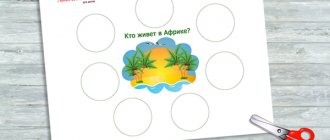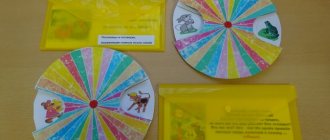"What changed?" — children's educational game with nesting dolls
The game develops the visual skills of preschool children. Trains a child, aged 3 - 4 years, to distinguish colors and sizes of objects, to remember the differences.
Type: Games with objects.
Didactic task: To train children in correctly naming objects and their actions (the nesting doll hid, ran, stood still), to notice and name the difference in the color of clothing and the size of the nesting dolls, to develop in children, aged 3 - 4 years, visual memory, voluntary memorization , observation, speech.
Game rule: Only the one who is named by the matryoshka - mother (the largest matryoshka) - answers.
Game action: Guessing what has changed in the arrangement of the nesting dolls.
Progress of the game: The teacher shows the children one by one five different-sized multi-colored nesting dolls. The children look at them. All nesting dolls are different in size and are dressed in different sundresses and scarves. Together with the children, the teacher names the colors of clothes and notes that all nesting dolls are different in size.
Children sit at a table in a semicircle; it is placed so that everyone can see the nesting dolls standing on the teacher’s table.
The teacher asks a question:
- Children, what do you see on my table? “Matryoshka dolls,” the children answer in unison. - Look at how tall the nesting dolls are. (Places two, then three, and then four nesting dolls next to each other.) Are they the same height or not? (“Different.”) What is different about them? Look carefully!
At first, the children find it difficult to answer correctly, the teacher helps them with leading questions:
- Look at the handkerchiefs. What are they? (Touches first one, then another nesting doll.) That's right. One nesting doll has a red scarf, another has a green one, and this one has a blue one. How can we say about handkerchiefs in one word? (“The nesting dolls have handkerchiefs of different colors.”) And sundresses? How can you say? Right. Their sundresses are also different. (Together with the children, name the color of each nesting doll’s sundress: red, green, blue.) Look at them and remember how the nesting dolls are dressed.
Now let’s play like this: I’ll cover the matryoshka dolls with a screen, and then you’ll find out which doll will hide. But you need to answer only one at a time, so the one who notices will come up to me and say quietly so that others do not hear. Next, the teacher draws the children’s attention to the size of the nesting dolls: he hides behind the screen first one, then another, then two at once.
When the game is played again, the one the matryoshka points to answers.
You can use other items in this educational game, depending on what problems are being solved.
What has changed.* Didactic task Game action. Rule. Equipment Game progress
Transcript
1 Houseplants are less familiar to younger preschoolers than vegetables and fruits. They often use everyday general definitions: “flowers”, “flower”, without knowing the exact name of a particular indoor plant. Children of the junior and middle groups in classes on learning about nature and in games should learn: 1. Names of indoor plants (for the younger group 1 2, then 2 3 more names are added to each group). 2. The structure of indoor plants: be able to determine their structure by comparing it with familiar objects of the plant world: “like a tree,” “like grass.” 3. Know the parts of plants: identify stems; the teacher introduces the word stem into the children’s active vocabulary gradually, replacing it first with the word branch; be able to describe the leaves: round, long oval (like a cucumber); color (green); size (large, small); leaf surface (smooth, non-smooth); be able to talk about flowers: the name of the color within the primary colors, the number on the peduncle (many, one). In order for children to better master this knowledge, the sequence of tasks in games with indoor plants needs to be changed compared to the previous group of games. First of all, children need to be shown that indoor plants are different from each other. The first tasks (“find the same”, finding objects by similarity) will help the teacher find out which of the children distinguishes plants and which does not. Then you should draw the kids’ attention to the most noticeable distinctive features of some plants. In the games, they are given a task: to find plants according to the description of an adult. Solving this problem allows children to pay attention to the shape, size of leaves, and color. When playing with indoor plants, the teacher names them, without first requiring the children to know the names. And only after some games the children are given the task of finding a plant by name. Children in the middle group already have some understanding of indoor plants, so more complex tasks can be introduced into their games with this material, for example, asking them to find plants based on an adult’s description. Then you need to repeat tasks that help the children describe the plant themselves. In this way, the teacher will draw the attention of preschoolers to the distinctive features of individual indoor plants and their structure. When conducting games with objects of the plant world, it is necessary that the teacher name them as often as possible. Games with the task “find a plant by name” are more difficult than games with vegetables and fruits, so they are played after children learn about plants. What has changed.* Didactic task. Find objects by similarity. Game action. Search for a similar item. Rule. You can show a recognized plant only upon a signal from the teacher, after listening to its description. Equipment. Identical plants (3 4 each) are placed on two tables. Progress of the game. The teacher shows some plant on one of the
2 tables, describes its characteristic features, and then invites the child to find the same one on another table. (You can ask the children to find the same plants in the group room.) The game is repeated with each of the plants on the tables.
3 Find the same Didactic task. Find objects by similarity. Game action. Children find changes in the arrangement of objects. Rule. It is impossible to watch how the teacher changes places of plants. Equipment. 3 4 identical plants are placed on two tables in a certain sequence, for example ficus, flowering geranium, asparagus, fragrant geranium. Progress of the game. The teacher asks the children to take a good look at how the plants stand and close their eyes. At this time, he swaps the plants on one table. And then he asks the children to rearrange the pots the way they were before, comparing their arrangement with the order of the plants on another table. After some repetitions, you can play the game with one set of plants (without visual control).
4 Guess the plant from the description* Didactic task. Find objects using the listed characteristics. Game action. Search for an object using a riddle-description. Rule. You can show the plant only after telling the teacher at his request. Equipment. For the first games, several indoor plants (2 3) with noticeable distinctive features are selected. They are placed on the table so that all children can clearly see each plant. Progress of the game. The teacher begins to talk in detail about one of the plants. First, for example, he notes what it looks like “like a tree,” like “grass”), then asks to say whether the plant has a stem. The teacher draws the children's attention to the shape of the leaves (round, oval like a cucumber, narrow, long), the color of the flowers (primary colors), their number on the peduncle. The first description is given at a slow pace, so that the children can see and consider everything about what the teacher says. Having finished the description, the teacher asks: “What plant did I tell you about?” Children show the plant and, if they can, name it. You can invite the children to find all the plants in the group room that are similar to the one described. Where the nesting doll hid!* First option. Didactic task. Find an item using the listed characteristics. Game action. Finding a hidden toy. Rule. You cannot look where the teacher hides the nesting doll. Equipment. 4 5 plants are placed on the table. Progress of the game. The children are shown a small nesting doll that “wanted to play hide and seek with them.” The teacher asks the children to close their eyes and at this time hides the toy behind one of the plants. Then the children open their eyes. “How to find a nesting doll? asks the teacher. Now I’ll tell you where she hid.” And the teacher says what the plant behind which the nesting doll “hid” looks like (like a tree, grass), describes its stem, leaves (shape, size, surface), flowers, their number, color. Children listen and then point to a plant and name it. Second option. The matryoshka "hides" behind any plant located in the group room.
5 Find the plant by name* First option. Didactic task. Find a plant by name word. Game actions. Search for the named plant. Rule. You cannot look where the plant is hidden. Progress of the game. The teacher names a houseplant in the group room, and the children must find it. First, the teacher gives a task to all the children: “Who can quickly find the plant in our group room that I name?” Then asks some children to complete the task. If it is difficult for children to find the named plant in a large area of the room among many others, the game can be played by analogy with the previous ones, that is, the selected plants can be placed on the table. Then finding a plant in the room will become a more complicated version of the game. Second option. You can play a game using a toy that the teacher or one of the children will hide (see the game “Where is the nesting doll hidden?”), but instead of describing the houseplant near which the toy is hidden, you can only give its name. What's missing! Didactic task. Name the plant from memory (without visual control). Game action. Guess which plant is gone. Rule. You cannot watch which plant is being harvested. Equipment. 2 3 plants that are well known to children from previous games are placed on the table. Progress of the game. The teacher invites the kids to look at what plants are on the table and then close their eyes. At this time, the teacher removes one plant. When the children open their eyes, the teacher asks: “Which plant is gone?” If the correct answer is received, the plant is put back in place and the game is repeated with another object. Note. The above games are recommended for children 3-4 years old.
6 Describe, I’ll guess* Didactic task. Find a plant according to the adult’s description. Game action. Guessing plants by riddle-description. Rule. First you need to find the plant that they will tell you about, and then name it. Progress of the game. The teacher describes one of the plants in the group room. Children must find it by description, and if it is familiar to them, then name it. Those plants whose names the children do not yet know are named by the teacher himself. When describing, you should use generally accepted terms: “leaf shape”, “flower color”, etc. This will help children identify the distinctive and general characteristics of the plant.
7 Find what I’ll tell you about* Didactic task. Describe and name the characteristics of the plant in response to questions from an adult. Game action. Making a “riddle” for an adult. Rules. You cannot name the plant being guessed. Answer questions correctly. Progress of the game. The teacher sits facing the children, with his back to the indoor plants standing on the table. The teacher asks one child to choose and show the children a plant, which he will then have to recognize from the children’s description. The teacher asks them questions about the presence of a stem, the shape and color of the leaves (names shades of green), about the surface of the leaf (smooth, non-smooth), whether there are flowers, how many there are on the branch, what color they are. For example: “What does a tree or grass look like? Is the trunk thick and straight? Are the leaves big, like a cucumber? Dark green, shiny? Having recognized the plant, the teacher names and shows it. The game can be repeated.
8 Make a guess, we will guess the first option. Didactic task. Describe objects and find them by description. Equipment. 3 4 plants are placed on the table. Game action. Making and guessing riddles about plants. Rule. You need to describe a plant without naming it. Progress of the game. One child walks out the door. He's a driver. Children agree on what plant they will talk about and what. The driver returns, and the children describe to him what they have planned. After carefully listening to the story, the driver must name and show the plant. Second option. The teacher invites one of the children to describe some plant standing on the table. The rest must recognize the plant from the story and name it.
9 Sell what I’ll name* Didactic task. Find an item by name. Game actions. Performing the roles of buyer and seller. Rules. The buyer must name the plant, but not show it. The seller finds the plant by name. Equipment. Select indoor plants, wildflowers and garden flowers. Unfold and arrange them on the table. Progress of the game. One child is a seller, the rest are buyers. Buyers name the plants they want to buy, the seller finds them and issues the purchase. In case of difficulty, the buyer can name the characteristics of the plant. groups. Note. The last three games are recommended for children of average age





